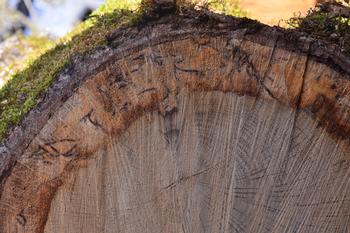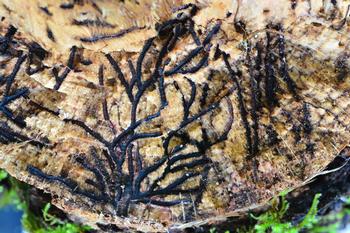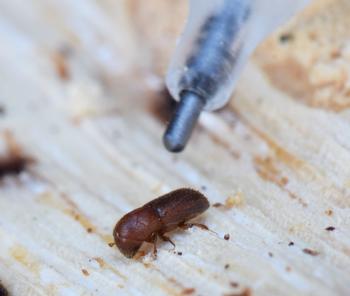New pest threatens oak trees
-
Barbara Robertson
-
Our native oak trees face a new threat. In November 2019, scientists in Calistoga discovered tiny symbionts – an insect-fungus team – killing mature Valley Oak trees (Quercus lobata). It was the first sighting in North America.
 This Napa Valley oak tree is infested with Mediterranean Oak Borer beetles. Photo: Shari Smith
This Napa Valley oak tree is infested with Mediterranean Oak Borer beetles. Photo: Shari SmithThe dangerous insect, Xyleborus monographus, is a European native ambrosia beetle called the Mediterranean Oak Borer (MOB). There are no reports of infestation in Marin County, but in early 2020, MOBs were discovered in Napa and Sonoma Counties.
“It’s on our doorstep,” says Steven Swain, UC ANR environmental horticulture advisor for Marin and Sonoma counties. Swain notes that MOB is now in Sacramento, too.
“It’s important for people to be on the lookout,” he says.
In addition to Valley Oaks, MOBs have attacked our native Blue Oaks (Quercus douglasii) and a distressed Black Oak (Quercus kelloggii). The beetles’ likely targets are drought, fire, or disease-stressed trees.
How do eighth-inch long beetles kill a mighty oak? Deadly Mediterranean Oak Borer beetles tunnel into a tree’s xylem where they plant & later harvest gardens of fungus. Photo: Curtis Ewing, CALFIRE
Deadly Mediterranean Oak Borer beetles tunnel into a tree’s xylem where they plant & later harvest gardens of fungus. Photo: Curtis Ewing, CALFIREMOBs excavate tunnels called galleries to plant fungal gardens in the trees. The fungi extract nutrients from the xylem, the tissue that moves nutrients from a tree’s roots to stems and leaves. Then, the beetles and their larvae gobble the vegetative part of the fungus (the mycelium) and clusters of fungus spores.
In other words, the fungi eat the trees and the beetles eat the fungi.
Studies are underway to understand the impact of the fungus on the trees, but mechanical damage from the tunneling seems to have the most impact.
MOBs tunnel in through thin or cracked bark and then colonize trees from the top down. Over several growing seasons, their population expands to reach massive density in the lower trunk. Females mate with siblings and males from unfertilized eggs and produce two or more generations per year. Eggs develop into adults in five to eight weeks. Mated females overwinter in the galleries and emerge in 80º F temperatures. They carry fungal spores in their mycangia, their “mouths,” when they fly to another tree.
Spotting MOB Unlike other beetles, the trellis-like tunnel pattern Mediterranean Oak Borer beetles create is chaotic. Photo: Curtis Ewing, CAL FIRE
Unlike other beetles, the trellis-like tunnel pattern Mediterranean Oak Borer beetles create is chaotic. Photo: Curtis Ewing, CAL FIRETo identify MOB-infested wood look for a particular architecture of tunnels. Unlike a typically regular pattern carved by other beetles, the MOBs’ gallery pattern is unique and chaotic. The tunnels are about one-sixteenth of an inch in diameter and fan out in a single plane, trellis-like, crowded, and intersecting.
A tree infested with MOB will show tiny exit holes and sawdust-like frass, both of which indicate tree stress. Neither is a sure sign of MOB, though, since other beetles do the same.
Instead, look at the upper branches.
“From what we’ve seen, infestations always start in the upper canopy,” notes Dr. Michael I. Jones, UC Cooperative Extension forest advisor for Mendocino, Lake, and Sonoma. “Early on, one branch begins to show severe decline while the rest of the canopy appears relatively healthy. As the infestation progresses, we see the entire canopy beginning to decline.” Also, sometimes heavily infested branches produce epicormic sprouting – water sprouts -- with small, densely clustered leaves.
Prevention This eighth-inch long Mediterranean Oak Borer beetle is endangering native oak trees. Photo: Curtis Ewing, CAL FIRE
This eighth-inch long Mediterranean Oak Borer beetle is endangering native oak trees. Photo: Curtis Ewing, CAL FIREIf you suspect an oak tree is infected, please report it. Infected trees can be unsafe.
“You won’t see dying limbs until the tree has lost the battle,” Swain says. “By that time, the tree is dangerous. These are big, big trees. The limbs will snap off while the tree is still green. It will go down quickly.”
There is no treatment yet for MOB. In Europe, trees have resistance, but our native oaks have less defense. So please, help prevent the spread. Female beetles can live in cut wood and can fly, so don’t buy oak firewood from infested areas. Check wood for the indicative galleries. Chip infested wood as small as possible. Solarize suspect wood and wood chips by wrapping everything in clear plastic. And, cut infested tree stumps low to the ground and cover with clear plastic.
Find more information here: https://www.ucanr.edu/sites/mobpc/.
To report MOB, go to www.cdfa.ca.gov/plant/reportapest or call at 1-800-491-1899. Help UC ANR with MOB research via this link: https://tinyurl.com/UCANR-MOBsurvey .




